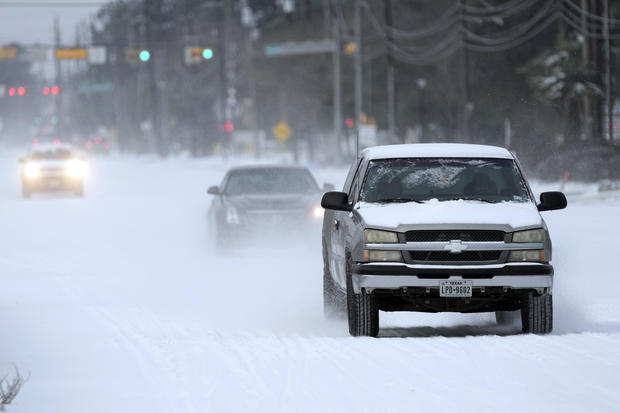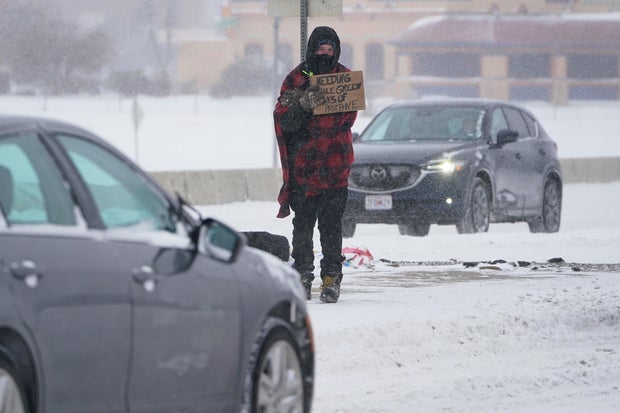At least three deaths have been linked to a massive weather system that’s bringing snow, sleet and freezing rain to the southern Plains and spreading across the Ohio Valley and into the Northeast. The frigid blast of winter weather plunged Texas into an unusually icy emergency Monday that knocked out power to more than 2 million people and led to dangerously snowy roads.
One person died on an interstate in Kentucky when they lost control of their vehicle and were hit by a semi truck, a state trooper confirmed to CBS News. A 78-year-old man died in Texas after falling on his front lawn and being stuck in the cold for two hours, and a 10-year-old boy died in Tennessee after falling into a frozen pond, officials said. The boy’s 6-year-old sister, who also fell through the ice into the pond, was taken to the hospital in critical condition.
In Texas, the worsening conditions halted the delivery of COVID-19 vaccine shipments and left some Texas providers scrambling to find takers for doses expiring within hours.
Temperatures nosedived into the single digits as far south as San Antonio, and homes that had already been without electricity for hours had no certainty about when the lights and heat would come back on. The state’s overwhelmed power grid throttled into rotating blackouts that are typically only seen in 100-degree summers, and Oncor, a utility that serves the Dallas-Fort Worth area and other parts of the state, said on Twitter the outages could last into Tuesday.
The Southwest Power Pool, a group of utilities across 14 states, called for rolling outages because the supply of reserve energy had been exhausted. Oncor advised customers to close blinds or curtains, close off rooms and stuff towels or rags into cracks under doors to avoid losing heat.
“We’re living through a really historic event going on right now,” said Jason Furtado, a professor of meteorology at the University of Oklahoma, pointing to all of Texas under a winter storm warning and the extent of the freezing temperatures.
CBS Dallas-Fort Worth reported that powerful winds were creating below-zero wind chills. For the first time ever, a wind chill warning was in effect for north Texas. Dangerously cold temperatures were expected Monday night and Tuesday.
Up to 400 record cold temperatures were possible across the country through the middle of the week, said CBS News meteorologist and climate specialist Jeff Berardelli.
In Houston, county leaders had warned that the freeze could create problems on the scale of massive hurricanes that slam the Gulf Coast.
“This weather event, it’s really unprecedented. We all living here know that,” said Dan Woodfin, senior director of system operations at the Electric Reliability Council of Texas. He defended preparations made by grid operators and described the demand on the system as record-setting.
“This event was well beyond the design parameters for a typical, or even an extreme, Texas winter that you would normally plan for. And so that is really the result that we’re seeing,” Woodfin said.
The slow thaw and more frigid lows ahead were also taking a toll on Texas’ distribution of COVID-19 vaccines. State health officials said Texas, which was due to receive more than 400,000 additional vaccine doses this week, now does not expect deliveries to occur until at least Wednesday.
But with doses already in-hand expiring, Rice University on Monday abruptly began offering vaccines on its closed Houston campus. Harris Health System told the school it had about 1,000 vaccines that “were going to go to waste” and asked if the school could find takers, said Doug Miller, a university spokesman. Miller later told the school’s student newspaper more than enough people had lined up for the vaccine by Monday afternoon.
Caught without enough groceries on hand, Lauren Schneider, a 24-year-old lab technician, walked to a Dallas grocery store near her home Monday morning dressed in a coat, hat and face mask. Schneider said she didn’t feel comfortable driving with the roads covered in snow and ice. She said she hadn’t seen a serious snowfall in Dallas since her childhood.
Several cities in the U.S. saw record lows as Arctic air remained over the central part of the country. In Minnesota, the Hibbing/Chisholm weather station registered minus 38 degrees while Sioux Falls, South Dakota, dropped to minus 26.
In Kansas, where wind chills dropped to as low as minus 30 degrees in some areas, Governor Laura Kelly declared a state of disaster.
Most government offices and schools were closed for Presidents Day, and authorities pleaded with residents to stay home. Louisiana State Police reported that it had investigated nearly 75 weather-related crashes caused by a mixture of snow, sleet and freezing rain in the past 24 hours.
Air travel was also affected. By midmorning, 3,000 flights had been canceled across the country, about 1,600 of them at Dallas/Fort Worth International and Bush Intercontinental airports in Texas. At DFW, the temperature was 4 degrees — 3 degrees colder than Moscow. Officials said the runways at Bush Intercontinental will remain closed until at least 1 p.m. Tuesday.
The southern Plains had been gearing up for the winter weather for the better part of the weekend. Texas Governor Greg Abbott issued a disaster declaration for all of the state’s 254 counties. Abbott, Oklahoma Governor Kevin Stitt and Arkansas Governor Asa Hutchinson each activated National Guard units to assist state agencies with tasks including rescuing stranded drivers.
President Biden also declared an emergency in Texas in a statement Sunday night. The declaration is intended to add federal aid to state and local response efforts.



